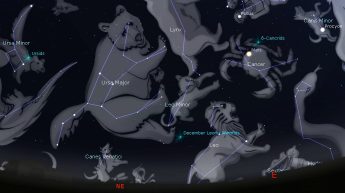This Week’s Sky at a Glance, 2024 Dec 21 – Dec 28
This Week’s Sky at a Glance, 2024 Dec 21 – Dec 28
This week, check out the eastern sky around 10 pm to hunt down four dogs, three cats, two bears, a hare, a snake and a crab. Oh, and a unicorn if you believe in them. Start looking toward the southeast where Orion is hunting. Below his feet is Lepus the Hare, staying immobile in hopes that Orion’s canine companions overlook him. Following Orion’s belt to the left brings you to sparkling Sirius at the heart of Canis Major the Big Dog, and it doesn’t take a great imagination to see a dog in this group of stars. Orion’s shoulders and head form an arrowhead that points toward bright Procyon, one of only a few visible stars in Canis Minor the Little Dog. Use your imagination to see Monoceros the Unicorn between the two dogs.
Now find the Big Dipper in the northeast. It forms the rear haunches and tail of Ursa Major the Big Bear, and from a rural area the legs and head of the bear can be seen easily. The two stars at the front of the bowl of the Dipper point northward to Polaris at the end of the handle of the Little Dipper, which is officially Ursa Minor the Little Bear. Below the handle of the Big Dipper are the two main stars and hounds of Canes Venatici the Hunting Dogs, seemingly nipping at the big bear’s butt.
Well below the bowl of the Big Dipper is Leo the Lion, recognized by the stellar backwards question mark of its chest and mane, with Regulus as its foreleg and a triangle forming its tail and hind legs. A faint triangle of stars between Leo and the Big Dipper is Leo Minor, the Little Lion. The third cat is Lynx, a faint line of stars running from Little Leo and past the front of Ursa Major. Between Regulus and Procyon is the head of Hydra the Water Snake, which will take much of the night to rise completely; and faint, crabby Cancer is above Hydra’s head and currently hosting Mars.
This Week in the Solar System
Saturday’s sunrise is at 8:00 and sunset will occur at 4:44, giving 8 hours, 44 minutes of daylight. Next Saturday the Sun will rise at 8:03 and set at 4:49, giving 8 hours, 46 minutes of daylight. The Sun reaches the Winter Solstice point around 5:21 this Saturday morning, the shortest daylight of the year (beating Friday by one second).
The Moon is at third quarter this Sunday. It near Spica on Christmas morning and the slim crescent rises near Antares next Saturday with Mercury a fist-width to their left. Mercury is at greatest elongation from the Sun on Wednesday, and that evening Venus sets after 8:30 pm followed by Saturn two hours later. On Thursday evening between, 6:25 and 7:00, telescope and binocular users might see Jupiter’s moon Io emerge from the end of a transit, and Ganymede emerge from an eclipse on the opposite side. Mars slowly edges westward against the background stars of Cancer over the week but remains within a binocular view of the Beehive star cluster (also called Praesepe, the Manger) until after Christmas. The minor Ursid shower is at its peak Sunday, with meteors emanating from between the Big Dipper and the North Star.

